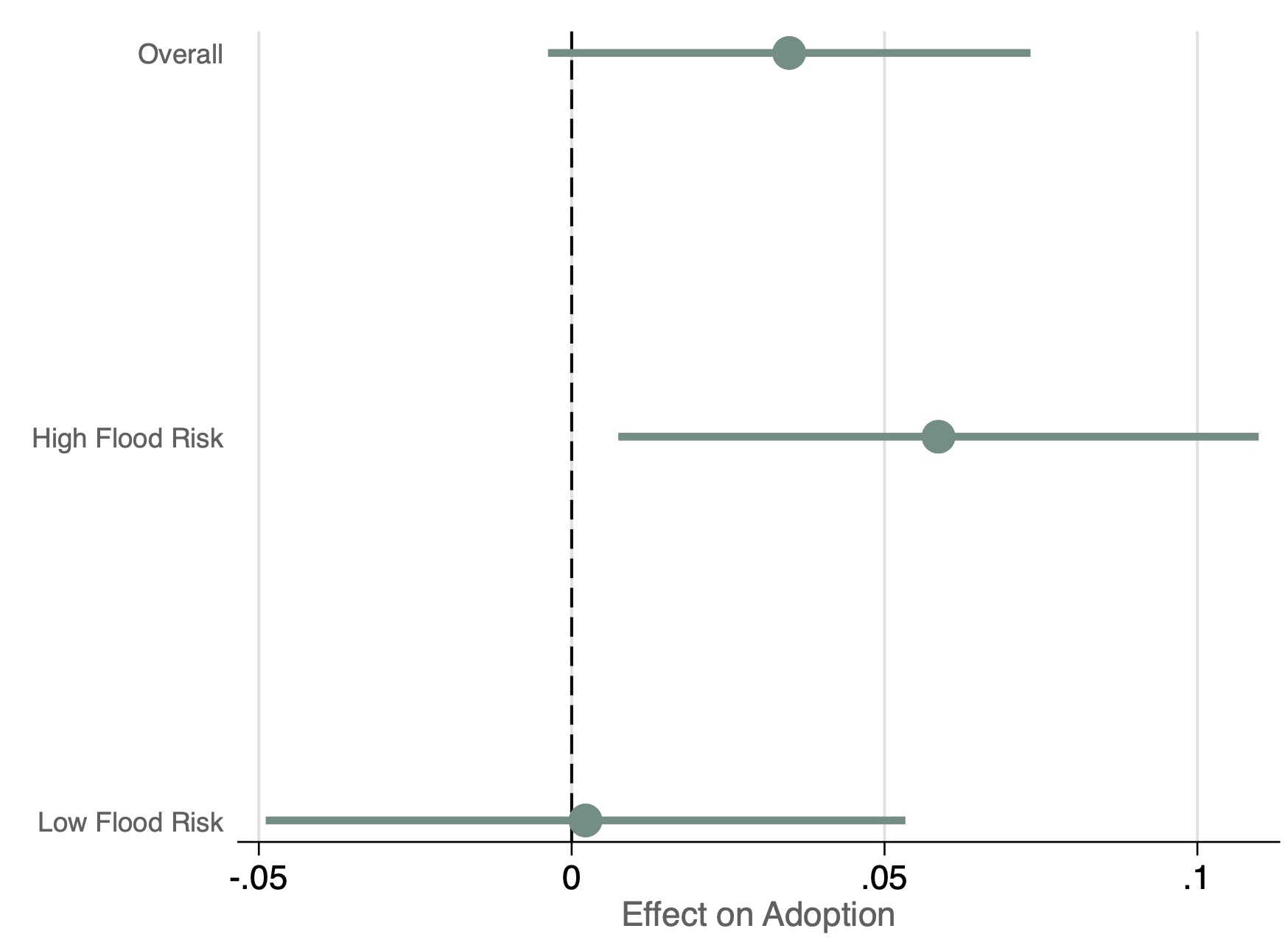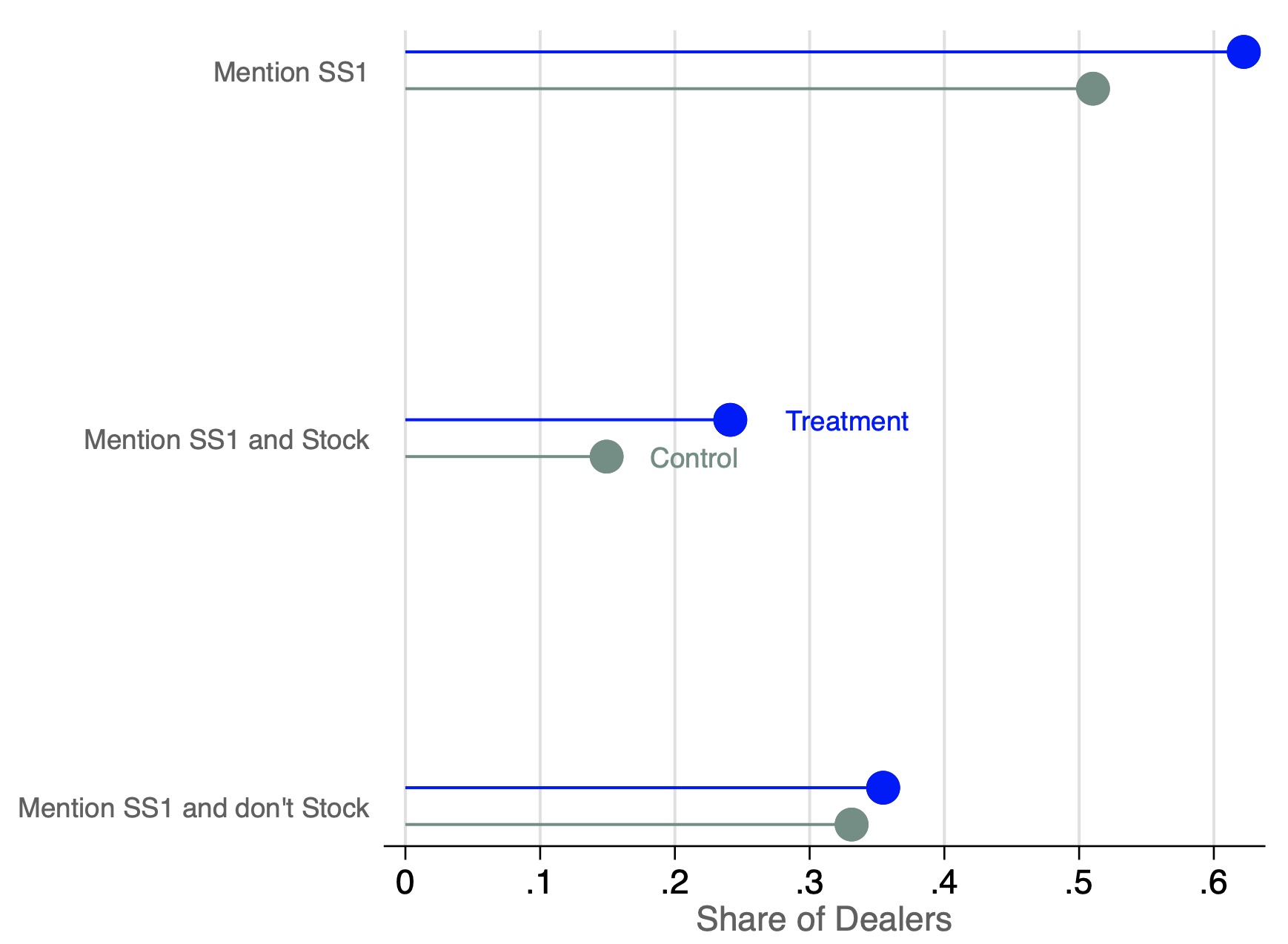
Small agricultural input suppliers can drive farm-level adoption of new technologies by over 50% more than conventional extension service methods
The private sector provides some public services in developing countries, for instance, water (Galiani et al. 2005) and healthcare (Das et al. 2016). Researchers have shown that, in some circumstances, private enterprises can simultaneously lower costs and improve the quality of services.
Agricultural extension: Information provision through contact farmers
In agriculture, international donor-supported research during the Green Revolution increased agricultural productivity and income per capita (Gollin et al. 2021). The role of informing farmers about these innovations was taken on by the public sector. In these agricultural extension programs, governments employ agents to act as intermediaries between researchers and farmers. Due to the limited number of agents, they select and train ‘contact farmers’, in the hope that the latter will spread information in their social networks (Kondylis et al. 2017, Beamen et al. 2021).
Lack of incentives for contact farmers to pro-actively diffuse information has limited the effectiveness of this approach (BenYishay and Mobarak 2019). A different model is to fully privatise agricultural extension. Numerous challenges have arisen with full privatisation, such as collusion between provider and farmer in sharing the fee collected from the government for extension services, and issues with quality of recommendations (Rivera and Alex 2004). A third approach is to provide agricultural extension services to small private input suppliers.
Measuring the effect of informing input suppliers on the spread of information and technology adoption
In our research, (Dar de Janvry, Emerick, Sadoulet and Wiseman 2021), we test whether engaging small private suppliers (‘agro-dealers’) can improve the delivery of agricultural extension services. Specifically, we modify the approach to agricultural extension by delivering seeds and information to agro-dealers instead of to contact farmers. In theory, agro-dealers – unlike contact farmers – have strong incentives to promote new technology; however, informing agro-dealers may not work if their incentives are not aligned with those of farmers.
We worked in 72 blocks, across 10 districts, in the state of Odisha in India. Prior to the 2016 wet season, we randomly divided the blocks into two groups:
- A control group of 36 blocks with conventional agricultural extension. We introduced 200 kilogrammes of a new flood-tolerant seed variety called Swarna-Sub1. Previous work (Emerick et al. 2016) shows that Swarna-Sub1 helps protect farmers from flooding risk, and induces them to invest more on their agricultural practices. Our teams provided the seeds to the government agricultural extension office in each block. As they usually do, the extension agents selected the farmers who received seeds for testing.
- A treatment group of 36 blocks where the same quantity of seeds was introduced, but they were provided to agro-dealers instead of farmers. This treatment modifies the conventional model of agricultural extension by providing information services to the suppliers of new technology. In contrast, the conventional model involves direct provision of information from extension agents to farmers.
We collected additional data over the next two years. First, during the 2017 season, we surveyed about 6,600 farmers across all blocks on their adoption of different rice varieties. Second, in the 2018 season, we sent secret shoppers (enumerators acting as farmers interested in buying seeds) to around 300 agro-dealers, to solicit advice on which seed varieties to grow. Data from the secret shoppers experiment provide a test of whether agro-dealers inform farmers directly about the new seed variety.
Private input suppliers are linked to increased adoption by farmers
Providing agricultural extension to private input suppliers increased adoption of Swarna-Sub1 during the following year (Figure 1). The treatment increases adoption by 3.5 percentage points, which is more than a 50% effect, since around 6.4% of farmers adopted Swarna-Sub1 in control blocks.
Figure 1 Effects of dealer-based agricultural extension on technology adoption

Note: This graph shows the percentage change in likelihood of adoption of Swarna-Sub1 by all farmers in the treatment blocks (top), farmers at high risk of flooding (middle), and farmers at low risk of flooding (bottom). As the graph shows, the effect is driven largely by farmers at high risk of flooding.
Through its flood tolerance property, Swarna-Sub1 benefits farmers in especially flood-prone areas. Using satellite imagery of flooding from 2011-2017, we divided our sample into higher and lower levels of flood risk. Figure 1 shows that introducing new technology to dealers increases adoption only for farmers that are most exposed to flooding. This evidence suggests that directing agricultural extension services through agro-dealers can increase adoption particularly by farmers with high returns from adopting the particular technology.
Informed agro-dealers share information with farmers
Secret shoppers re-visited agro-dealers two years after the seeds had been introduced. As shown in Figure 2, about 51% of agro-dealers in control blocks mentioned Swarna-Sub1 to the secret shopper. This increases to 62% in blocks where agro-dealers had been introduced the technology. Moreover, the information transmission is limited to agro-dealers who were currently selling Swarna-Sub1: the treatment increased the share of agro-dealers who both mentioned and stocked Swarna-Sub1 from 15% to 24%. The data thus indicate that direct information transmission is one mechanism through which better informed agro-dealers lead to more adoption of improved technology.
Figure 2 Sharing of information about Swarna-Sub1 by agro-dealers

Note: This graph shows the share of agro-dealers in the treatment (blue) and control (green) blocks who mention Swarna-Sub1 to farmers. The top bar shows the overall share of agro-dealers who mention Swarna-Sub1; the middle bar shows the share of agro-dealers who both mention and stock the seed, and the bottom bar shows those who mention the seed but do not stock it. As the graph shows, the effect is driven largely by agro-dealers who stock the seed.
Implications for public agricultural extension
While public agricultural extension programs typically operate by training selected farmers directly on new technology, input suppliers are the second-most-common source of information for Indian farmers (NSSO 2021). Our results provide evidence on input suppliers as an indirect channel, through which farmers can learn better. Making input suppliers more informed can lead to them passing information to farmers, who are then more likely to use improved technology.
These findings suggest that in some cases, working with agro-dealers can improve the process of public agricultural extension. While this is distinct from privatising the service, it implies greater involvement of private business-motivated agents in the process of farmer learning. We see value in testing this approach in more settings, to determine whether reducing information frictions on the supply side of technology can work in other contexts.
References
Beaman, L, A BenYishay, M Mobarak and J Magruder (2021), “Can network theory-based targeting increase technology adoption?”, American Economic Review 111(6): 1918–1943.
BenYishay, A and A M Mobarak (2019), “Social learning and incentives for experimentation and communication”, The Review of Economic Studies 86(3): 976-1009.
Dar, M, A de Janvry, K Emerick, Elisabeth Sadoulet and E Wiseman (2021), "Private input suppliers as information agents for technology adoption in agriculture", CEPR Discussion Paper 15584.
Das, J, A Holla, A Mohpal and K Muralidharan (2016), "Quality and accountability in health care delivery: Audit-study evidence from primary care in India", American Economic Review 106(12): 3765-99.
Emerick, K, A de Janvry, E Sadoulet and M Dar (2016), “Technological innovations, downside risk, and the modernisation of agriculture”, American Economic Review 106(6): 1537–1561.
Galiani, S, P Gertler and E Schargrodsky (2005), "Water for life: The impact of the privatization of water services on child mortality", Journal of Political Economy 113(1): 83-120.
Gollin, D, C Hansen and A Wingender (2021), “Two blades of grass: The impacts of the green revolution”, Journal of Political Economy 129(8): 2344–2384.
Kondylis, F, V Mueller and J Zhu (2017), “Seeing is believing? Evidence from an extension network experiment”, Journal of Development Economics 125:1–20.
NSSO (2021), "Situation assessment of agricultural households and land and livestock holdings of households in rural India, 2019".
Rivera, W and G Alex (2004), "Volume 2 - Privatisation of extension systems: Case studies of international initiatives, agriculture, and rural development", Tech. Rep. Discussion Paper 9, Washington, DC: World Bank.




